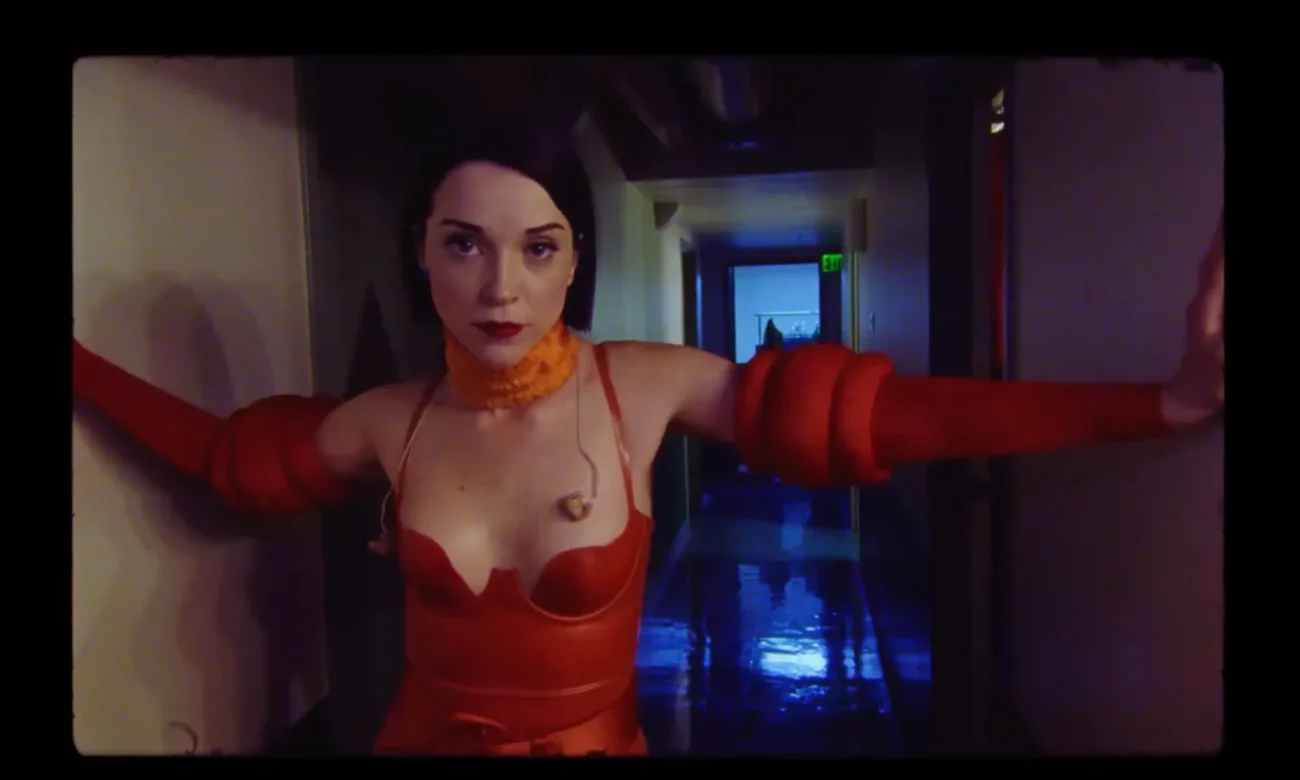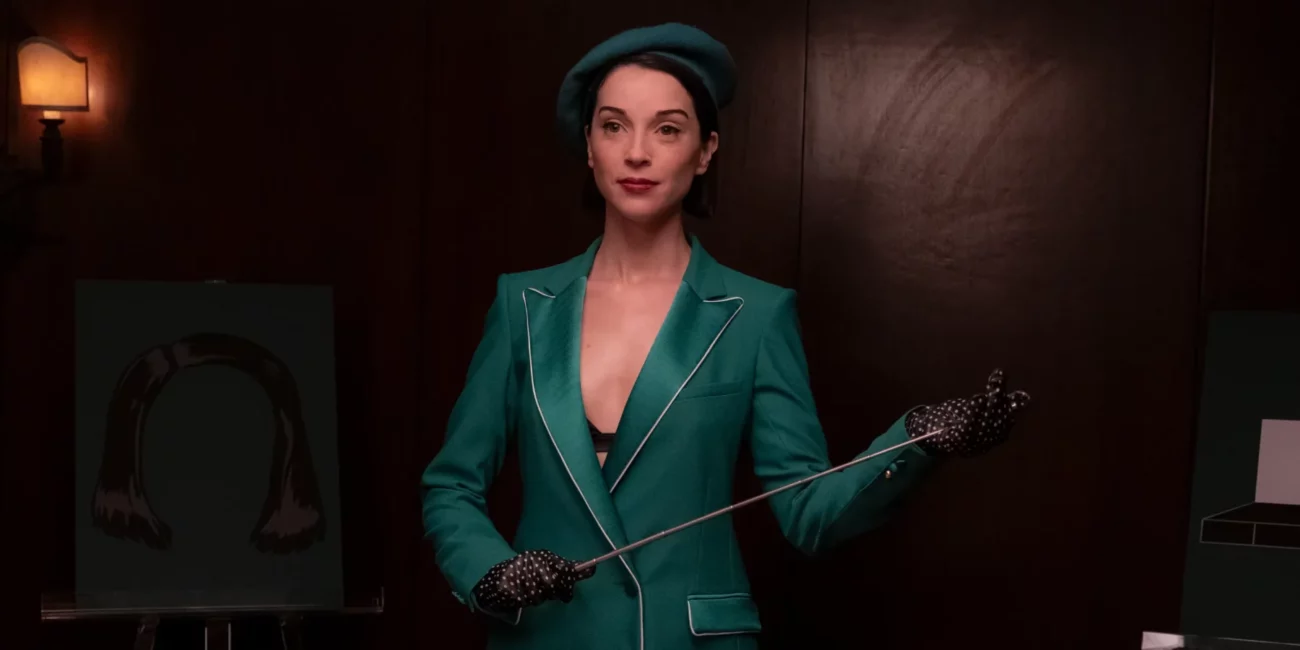It’s not uncommon to make rock & roll musicians the topic of a mockumentary. This is Spinal Tap is one of the most widely recognized examples of the genre, but it is by no means the only one. Christopher Guest, one of the most prolific directors in the mockumentary genre, threw his hat into the ring with A Mighty Wind starring dynamic duo Eugene Levy and Catherine O’Hara. Popstar: Never Stop Never Stopping is quietly gaining cult status after its less-than-stellar box office numbers. Any sort of music genre you can ask for probably has a mockumentary.
People love the idea of rock stars and pop stars. Music is such an integral part of most people’s daily lives that they’d probably be lying if they said they’d never dreamed of becoming a rock star. There’s something intrinsically fascinating about getting to see behind the curtain of this lifestyle, even if it is fake. A life on the road, playing sold-out shows every night, and having crowds of adoring fans is romantic in a nomadic, unattainable way.
On the surface, Annie Clark is more unattainable than most rock stars. Many fans may know her only by her stage name—St. Vincent—so the woman performing is hidden behind another layer of mystery. Who is St. Vincent? Who is Annie Clark? Do they have anything in common other than the body and mind they inhabit?
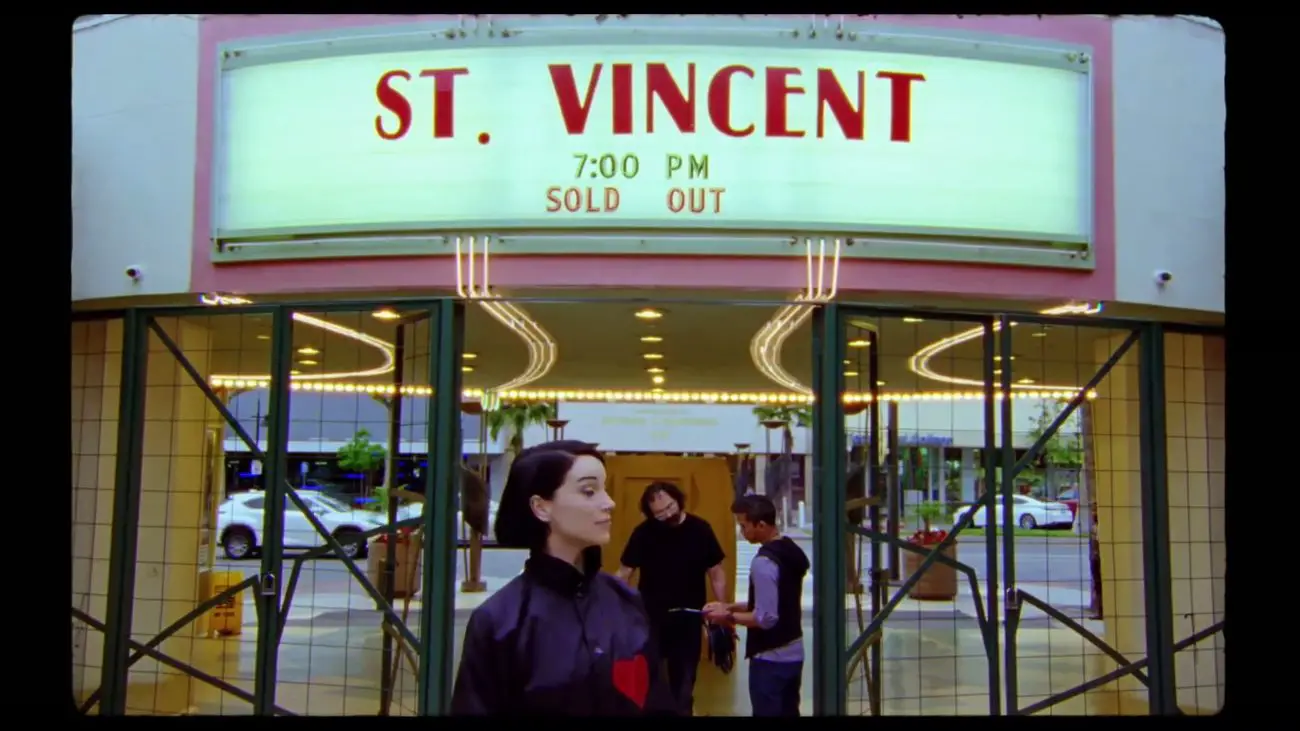
The Nowhere Inn attempts to answer those questions. The premise of the film is a little confusing because Annie Clark and Carrie Brownstein wrote and star in the movie: they’re real-life friends playing fictionalized versions of themselves. Carrie is in a creative rut and decides to make a documentary about Annie/St. Vincent while she’s touring her newest album, Masseduction. This excites Annie because she views the documentary as her first opportunity to control the narrative of who she is. It’s a chance to let her fans see the real Annie.
Carrie is adamant that she wants Annie to be natural in the documentary, but it becomes very clear that Annie and St. Vincent are starkly different. Annie says so herself, “Well, my name is Annie Clark, but I perform as St. Vincent.” Where Annie prefers lowkey activities like playing Scrabble or video games on her Nintendo Switch, St. Vincent is loud and commanding. Even with these differences, it’s hard to know if this is a genuine conflict of personalities. Is the Annie Clark the audience sees, the one who revels in her quiet routine, the actual Annie Clark? Or is it yet another performance?
Because of Carrie and Annie’s real-life friendship and Annie’s actual music career, it’s difficult to find the line between reality and fiction. In most mockumentaries, this distinction is much clearer. The actors are usually more removed from their roles, but The Nowhere Inn blends in real concert footage from St. Vincent’s Fear the Future Tour. The closeness of the role and the actor adds a surrealism to the film that is thought-provoking. Is this mockumentary Annie’s true feelings coming out or simply a creative exercise between two friends?
It becomes evident to Carrie very quickly that a documentary about Annie playing video games is not going to be the movie that will get her out of her creative block. The concert footage is exciting, but Carrie wants this documentary to be more than just a concert film. She tries to push Annie to do exciting things, like after-show dance parties on the bus, to add a liveliness to the documentary, but Annie points out that they’ve never had a dance party on the bus.
Annie’s on-stage persona has allowed her an unusual amount of anonymity in her day-to-day life. A limo driver who boasts that he’s driven many famous people keeps asking Annie who she is. He even goes so far as to call his son, who knows musicians, to see if he knows who Annie is. The driver asks her to sing one of her popular songs, and Annie obliges by singing “New York.” It doesn’t ring any bells for the driver or his son, and before rolling up the divider, the driver says, “don’t worry, we’ll find out who you are.”
This opening scene comes across as threatening and creates an eerie sense of uncertainty that lingers through the rest of the movie. Who Annie and St. Vincent are is at the heart of the film. It’s clearly something that weighs on this fictionalized version of Annie. In what seems to be an honest comment from the actual Annie, she says, “how you think you seem and how you actually seem, sometimes the gulf is catastrophic. The idea is to have how you sound and how you think you sound be actually very married.”
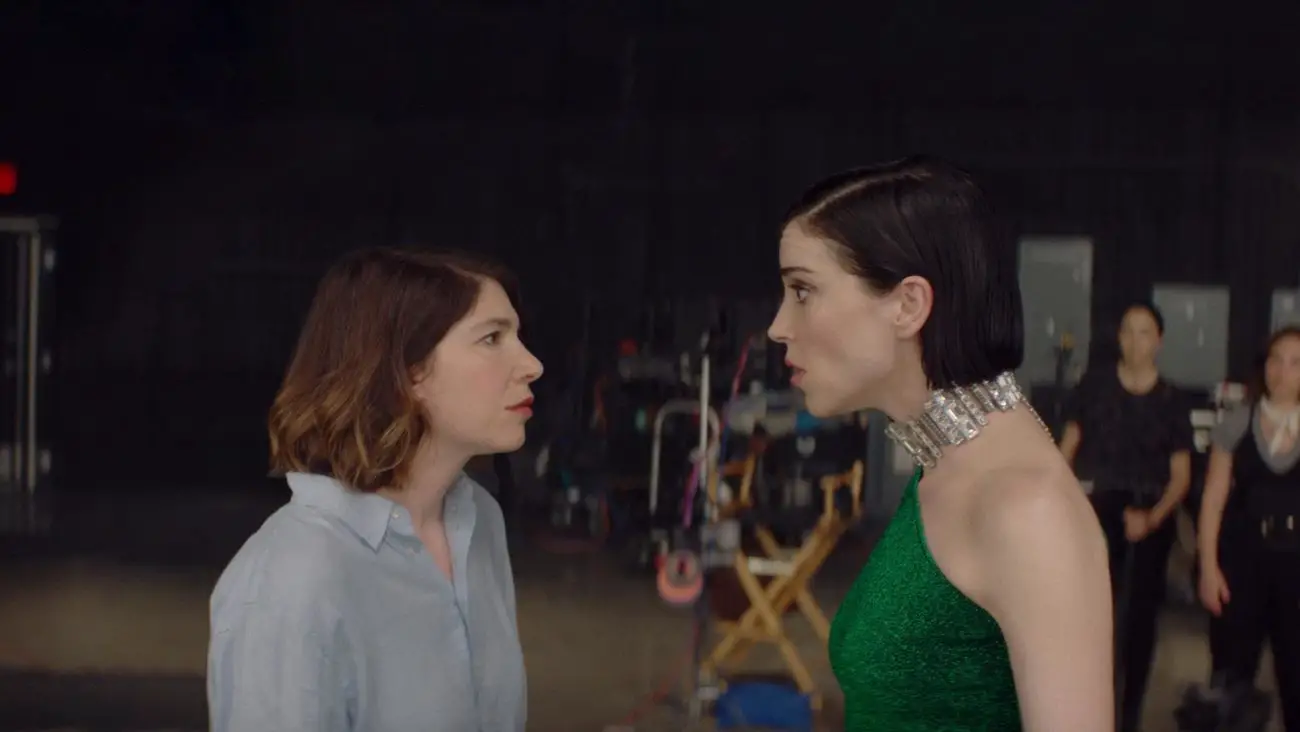
Later, when Carrie grows frustrated at the lack of footage she’s getting from Annie, they have a big blow-up. Annie says “I can’t be who you want me to be” and Carrie tells her that no one is going to want to watch this boring documentary. It’s a direct insult to the reason Annie wanted to be in the documentary in the first place. She wanted to honestly show off who she is, but now she’s being told by one of her closest friends that Annie Clark isn’t interesting enough to be the focus of a movie. That her only value is in her performance as St. Vincent. Carrie wants the sultry, assertive St. Vincent? Then that’s exactly who she’ll get.
At this point, Annie morphs into the rock star persona of St. Vincent to give Carrie the movie she’s been asking for. Annie asks Carrie to film her smoking a cigarette moments before she goes onstage, which confuses Carrie because Annie doesn’t smoke. “This is how actors play rock stars in movies,” Annie says. Carrie stares at her incredulously before pointing out “but you are a rock star.”
Annie’s transformation into the image of a rock star is darkly comedic. From her relationship with Dakota Johnson (as Dakota Johnson) to her insistence that everyone on her tour wear St. Vincent wigs, the movie shifts into a new level of absurdism. It’s delightful and ridiculous to watch Annie break up with Dakota while she’s wearing a St. Vincent wig. Even Annie’s reason for a break-up is farcical: she’s happy with Dakota, but she needs to write another album, so she needs to be heartbroken. Obviously, Dakota doesn’t take this well and storms off. Annie is livid, saying “from now on, I need more say in how other people are going to act.”
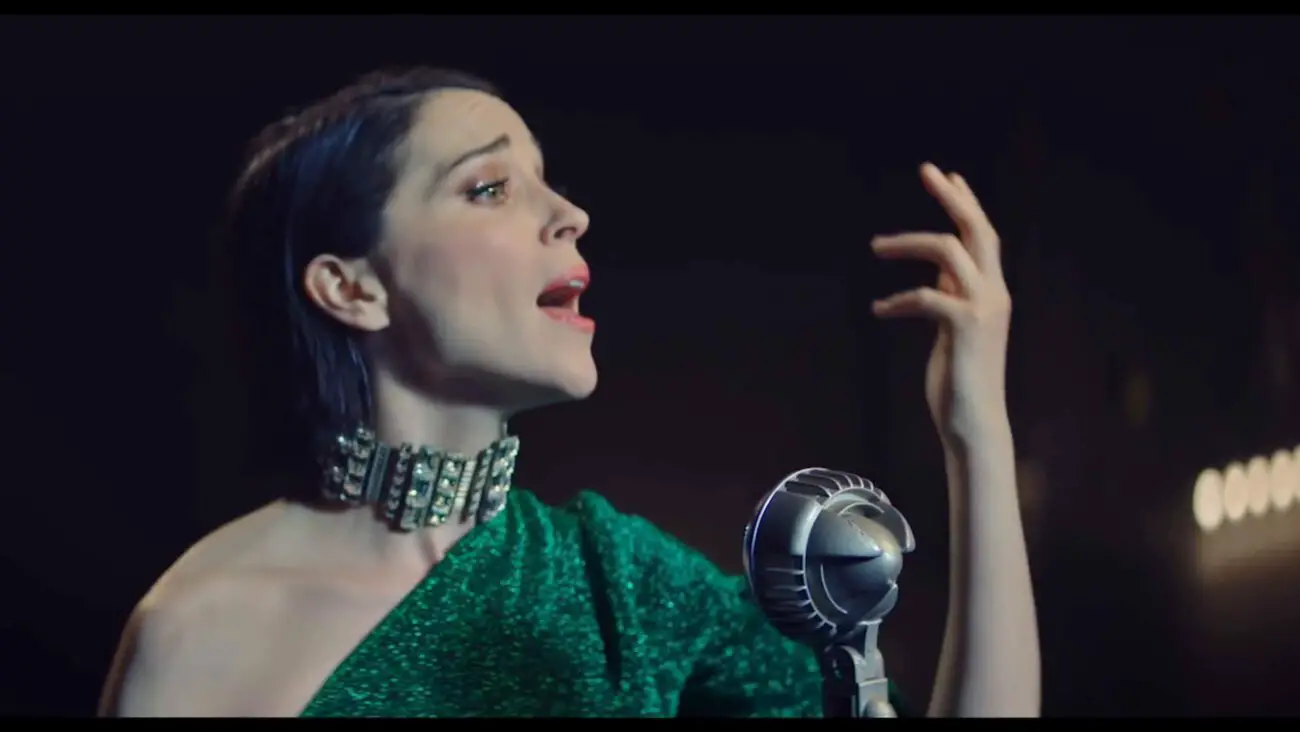
At times, The Nowhere Inn feels like it could have been made by David Lynch, a spiritual sister to Mulholland Drive, but where things make a little more sense. Annie’s performance of the song she and Carrie wrote for the film, “The Nowhere Inn,” doesn’t feel too far off from the infamous Club Silencio scene of Mulholland Drive. Had Annie passed out while the song continued on, it wouldn’t have felt out of place in the slightest. The “horror” of the Club Silencio scene lies in the “no hay banda” revelation. There is no band and the woman performing the opera wasn’t actually singing. Backed by Lynch’s beloved red curtains, the scene’s purpose is to expose the artificiality of art.
Annie’s performance of “The Nowhere Inn” serves a similar purpose and expands upon a sentiment from earlier in the film. “The audience doesn’t need me, I’m only a vessel for their feelings.” What Annie doesn’t realize in that moment is that the relationship between performer and audience is symbiotic. One cannot exist without the other because there is not a performance unless someone is around to witness it.
When the curtain rises as Annie sings “The Nowhere Inn,” there is another version of her performing the same song on the same stage at the same time. They are making the same gestures, effortlessly mimicking one another. The curtain drops closed again and the original Annie frantically tries to chase her clone down, but she’s stuck in an endless loop of closing curtains. Eventually, she bursts through the curtains to an all-white space and her clone is there with her back to Annie. She cautiously approaches her clone and spins her around to look at her face. To her surprise, Annie is met again with the back of her clone’s head.
Annie keeps spinning her clone around and around hoping to get a glimpse of her face, but eventually gives up. She then reaches into the clone’s hair and pulls out a gold ring with “St. Vincent” etched into it. Annie studies it momentarily before swallowing it as the lyrics, “here at the Nowhere Inn / Where nothing and no one win” echo around her.
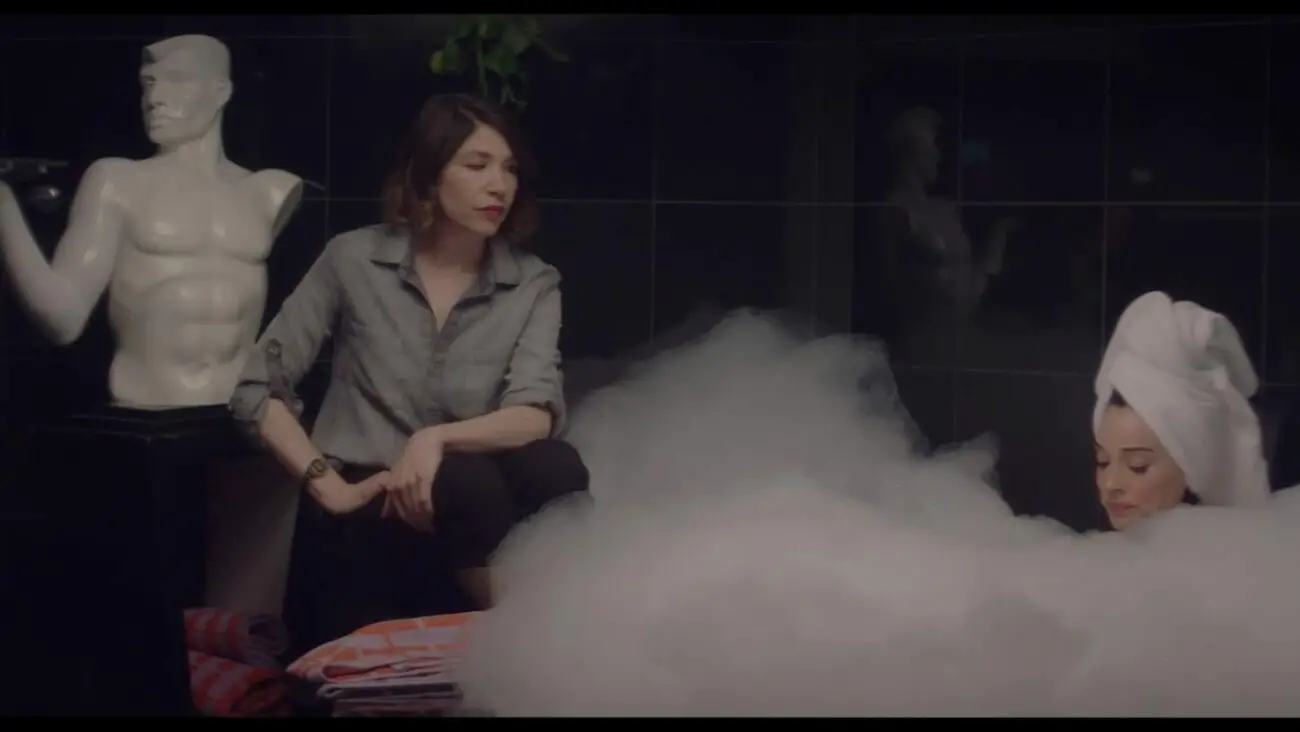
It’s an acceptance of sorts. An understanding that, for better or for worse, the monster of St. Vincent (no matter how blown out of proportion for the sake of the film) is part of the human being that is Annie Clark. In the same way that the relationship between audience and performer is symbiotic, so is the relationship between Annie and St. Vincent. They need one another and do not exist as separate entities. In so much of the film, people around Annie believe that there is a concrete difference between Annie Clark and St. Vincent, but humans aren’t like that. They move fluidly between various aspects of their personality depending on the situation and the people they’re around. Sometimes those personalities bleed into one another.
Identity and sense of self are the overarching themes that both the real-life and fictional Carrie and Annie are interested in exploring. As musicians (Carrie fronts Sleater-Kinney), actors, writers, and directors, they are uniquely poised to make a mockumentary about the weight of expectation. Once a certain level of fame is reached, celebrities lose their sense of self. They become the commodity and their genuine identity becomes muddled. Based on their work, people now have assumptions of how the celebrity should walk, talk, and act. Fans demand celebrities living up to these expectations at the drop of the hat.
Annie is in the middle of an interview when the woman interviewing her, Holly (Rya Kihlstedt), becomes distracted. Her girlfriend is breaking up with her over text message. Annie’s obviously frazzled, unsure of how and if she should comfort a woman she met mere minutes ago when Holly asks Annie to make a voice recording for her soon-to-be ex-girlfriend. Annie’s essentially cornered, so she obliges and starts off by saying, “Hi, this is Annie Clark” before Holly stops the recording. “Can you say St. Vincent? Then she’ll know who you are.”
Holly uses Annie’s own identity as a weapon against her. Once again, the St. Vincent part of Annie is seen as the only aspect of her identity that contains value. Annie agrees to Holly’s request and re-records the message. Holly has a few other requests like Annie mentioning how great Holly is and extra tickets for Annie’s upcoming show. Annie takes all of these requests in stride with a smile plastered on her face because she knows that if she were to speak freely, Holly’s article would turn into a hit piece.
Holly brings her girlfriend to the St. Vincent show because the message Annie recorded worked and their relationship was saved. They’re sitting in their seats before the show and Holly says how stuck-up and pretentious Annie was. Little does she know, Annie is within earshot. This moment is the catalyst for Annie to given in to Carrie’s pleas for her to act more like St. Vincent. It proves to Annie that no matter what she does or how she presents herself, people are going to see her the way they want to see her. In a sense, this whole movie is futile. Annie’s attempt at taking control of the narrative of her identity is fruitless because it has, and always will be, about perception.
The film is more surrealist than most mockumentary fare, but Annie and Carrie add a realism to their fictional selves that elevates it beyond a simple comedy, concert, or psychological film. It’s a fascinating introduction to the musician known as St. Vincent. Equally showing off Annie’s talent as a performer and an actor, The Nowhere Inn is a Lynchian ode to the performance of identity.

